Sales Event “Valley Of Death”: How To Restore Revenue Growth When Performance Marketing Falters
Click here to watch a 12-minute video of the key findings.
For some advertisers, the primary marketing strategy is “buy now,” a relentless series of sales events and promotions. Ad copy is rational, product and price focused, with limited time offers.
Some call this “performance marketing” or “converting existing demand.” The goal is to target people who are in the market.
Performance marketing “valley of death”: When converting existing demand dries up
As the new study from James Hurman and WARC, the World Advertising Research Center, reveals, sales plateau when demand hits a wall. Simply put, the sales event machine stops working when the supply of in-market consumers aware of a brand has been exhausted.
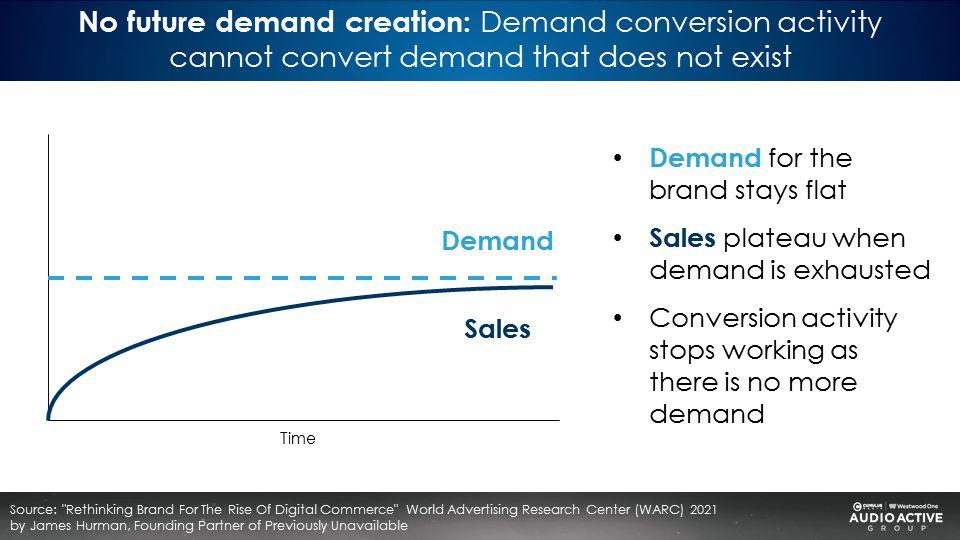
Auto intenders: Only 3% are in-market for a new vehicle; Sales event ads only work on the small group who are ready to buy
The Ehrenberg-Bass Institute of Marketing Science reports only 5% of consumers are in the market for a product or service at any point in time. This holds true for business-to-business and consumer categories.
In the case of local auto dealers, new vehicle sales data reveals only 3% will purchase a vehicle during a three-month period. So the “hurry, hurry, buy now” advertising strategy only works on the 3%. For those not in the market, sales event ads are ignored or seen as irritating.
Auto future demand: 24% will purchase a vehicle over the next two years
There is a much larger group of people who are not ready to buy now but will be ready within a few years. In the case of automotive, 24% could be in the market over the next two years. Auto future demand is eight times bigger than existing demand (24% future demand versus 3% in-market demand).
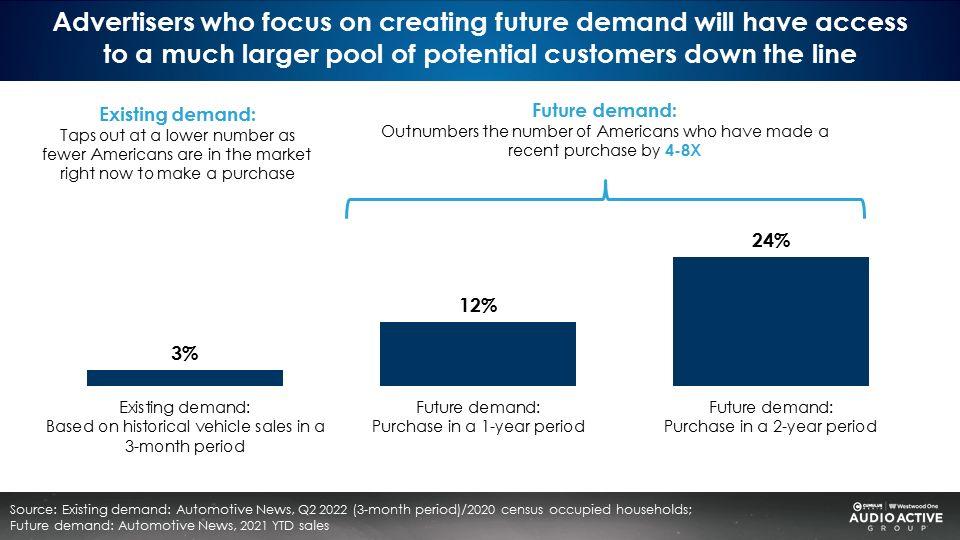
How can brands and advertisers attract the attention of future demand consumers? It requires very different media and creative strategies.
Creating future demand is like planting apple trees: Be known before you are needed
If sales event/performance marketing is about picking apples, creating future demand is planting apple trees. That takes six months to a year.
Some call creating future demand brand building. Brand building is “being known before you are needed,” according to advertising expert Spike Santee.
Instead of the narrow targeting of in-market consumers, creating future demand is about mass reach to attract that much larger group who are not yet ready to buy. Remind the many. Don’t lecture the few.
The creative approach to convert existing demand is rational and promotional. Creating future demand ad copy is very different. It is emotion-based creative designed to be memorable, entertaining, and create positive feelings.
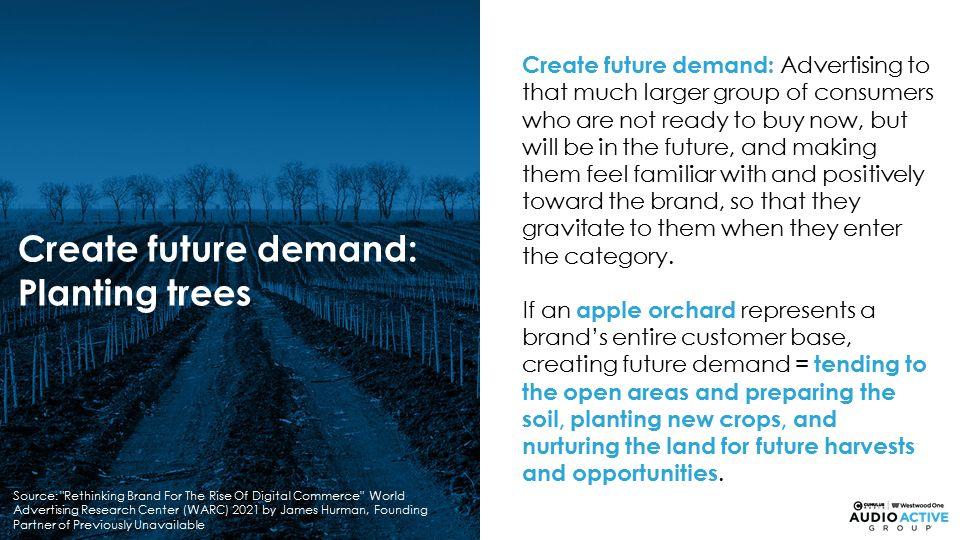
James Hurman also just published a wonderful new Kindle book on how to create future demand entitled Future Demand: Why Building Your Brand Among Tomorrow’s Customers Is The Key To Start-Up Success.
Converting existing demand generates short-lived sales spikes; Creating future demand results in long lasting business outcomes
This comparison of the two approaches reveals the key differences in both the media plan and creative between the two important jobs of advertisers. Both need to occur at the same time.
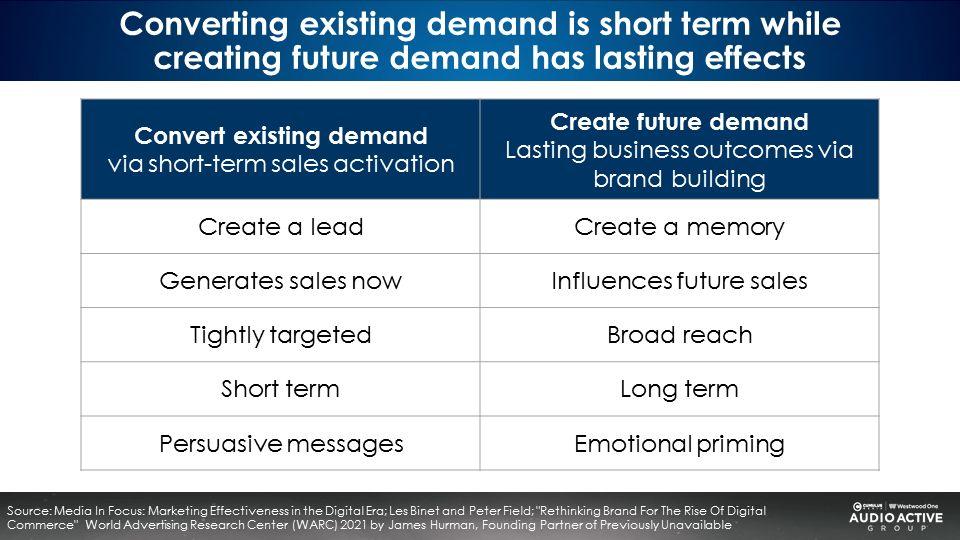
What happens when businesses driven by sales events begin to create future demand? At first, nothing
The way to escape the performance marketing “valley of death” is to begin creating future demand. Be patient. You cannot expect to immediately pick apples from trees you just planted!
According to Hurman and WARC, when a business primarily driven by sales events begins brand building advertising to create future demand, there is a period when flat sales persist while future demand is being created. It takes time for future demand to build over time. Eventually, sales pick up when sufficient future demand has been created.
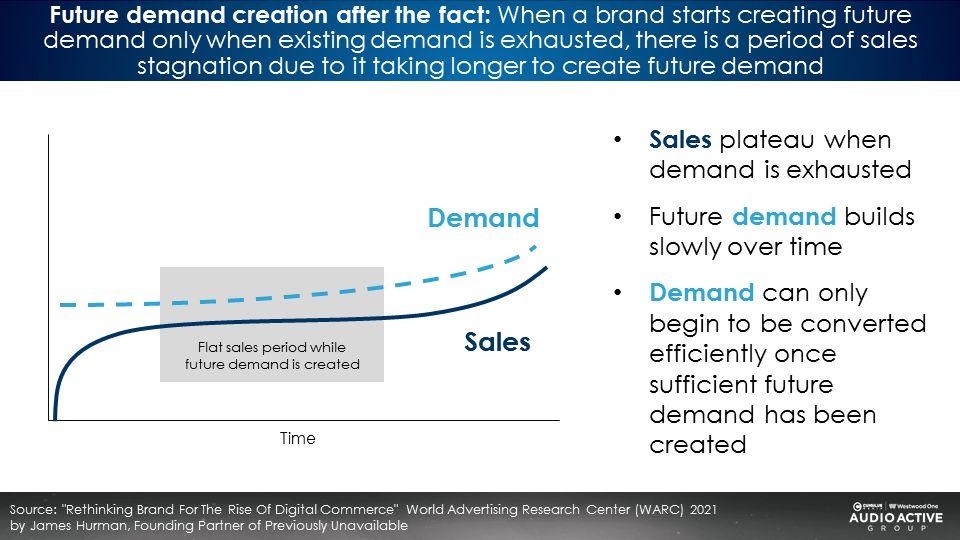
Firing on all cylinders: When a business consistently uses brand building to create future demand and sales events to convert existing demand, great things happen
According to Hurman and WARC, when future demand is created consistently, sales growth can be maintained. Successful businesses constantly plant new apple trees while picking ripe apples from orchards that have grown over time.
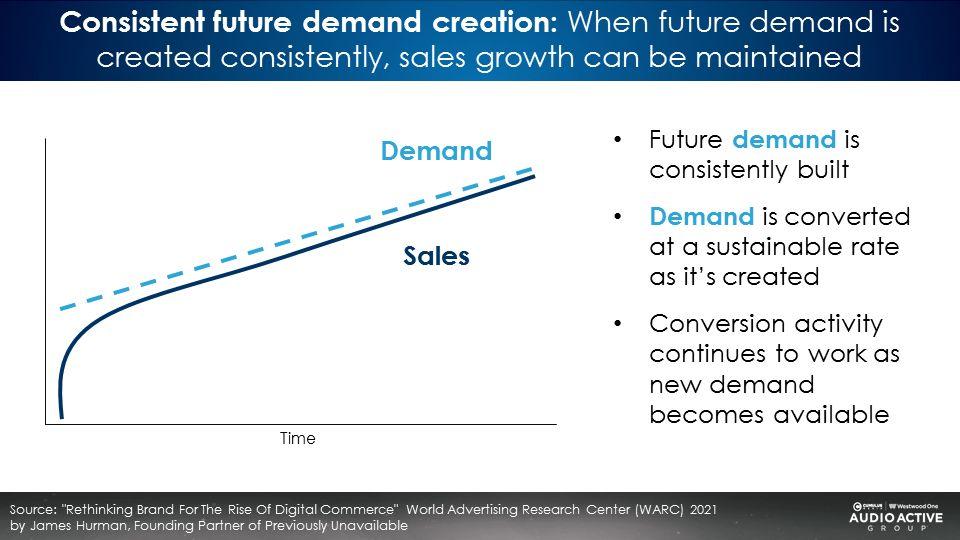
The ideal budget mix: 40% for sales events and 60% to create future demand via brand building
Les Binet and Peter Field, the renowned godfathers of marketing effectiveness, advise 60% of ad budgets should be devoted to creating future demand via brand building and 40% should be allocated to sales events that convert existing demand.
Binet and Field’s extensive sales effect research reveals these ratios can be adjusted based on how the product is purchased (offline vs. online), the size of the business, and product pricing.
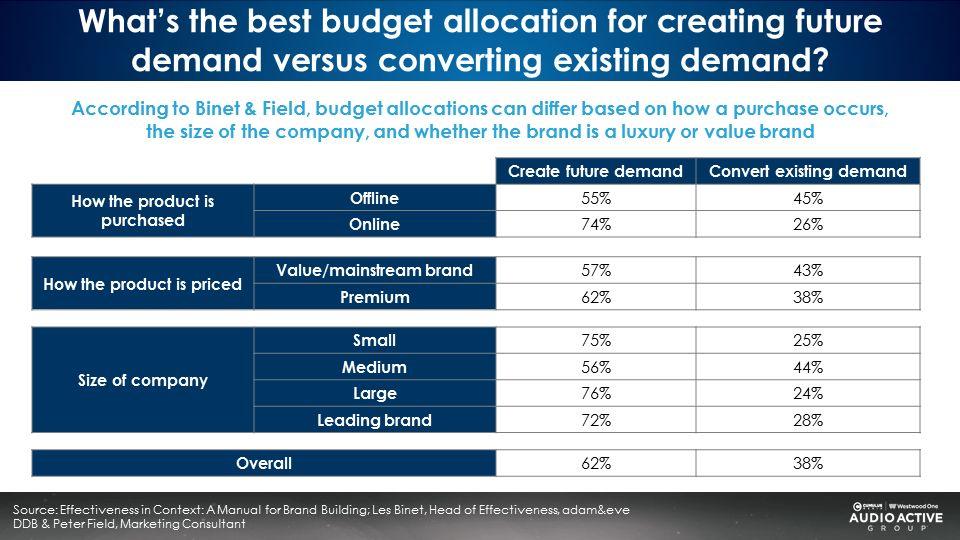
Pricing power is the unforeseen benefit of using brand building ads to create future demand: Customers are willing to pay more for strong brands
Stores and businesses with strong brands generate better sales and profits. Kantar Millward Brown reports strong brands generate five times more sales volumes than weak brands.
More importantly, strong brands have more pricing power than weak brands. Pricing power generates greater profit.
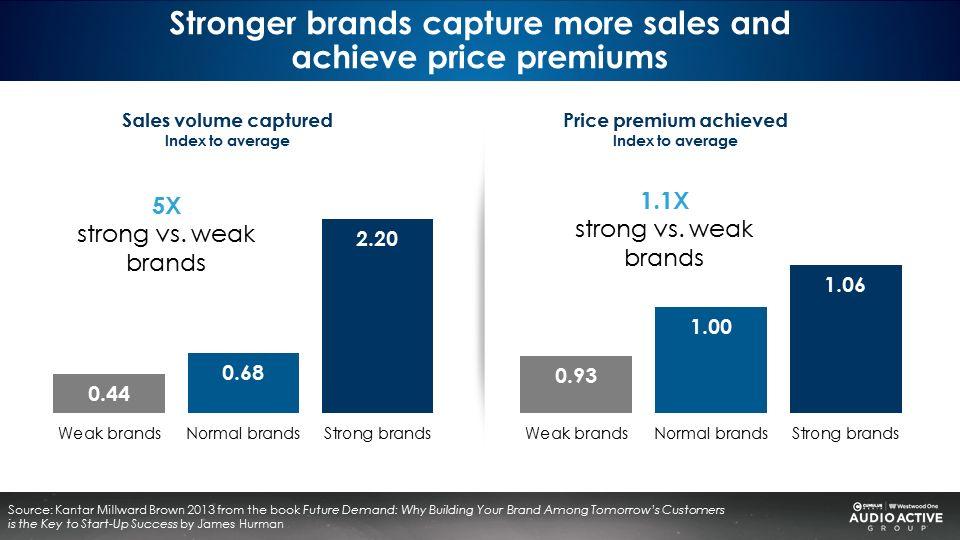
Warren Buffett: “If you’ve got the power the raise prices, you’ve got a good business”
Warren Buffett has made a career of investing in companies with strong brands. Companies with strong brands recover faster from uncertain economies and have greater consumer purchase intent.
Brands that create future demand will reap the benefits when new inventory arrives and shoppers return
It is not uncommon for car dealers to cease advertising because of tight inventories. They are half right. Remember the two most important jobs of advertising are converting existing demand and creating future demand.
In times of tight inventories, it is wise to dial down sales event ads to convert existing demand. After all, current demand outstrips supply. However, now is the perfect time to ramp up the creation of future demand via brand building advertising.
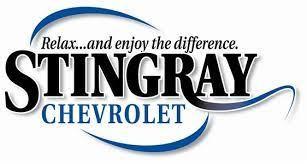
The August 8th issue of Radio Ink Magazine featured Steve Hurley, the dealer principal of Stingray Chevrolet in Plant City, Florida. Stingray Chevrolet uses brand building advertising featuring Hurley that tout “not charging over sticker price, treating people with respect, and treating people fairly.” Classic brand building. Being known before you’re needed.
Hurley also uses AM/FM radio to promote the “Unity in the Community” charity which distributes funds to 30 to 35 local community groups that support food for the poor, backpacks for kids, and summer reading programs. Hurley says online raffle ticket sales for the charity are powered by AM/FM radio ads.
The impact of Hurley’s brand building? “We are selling four to six times the number of Chevrolets we should be selling.” Brand building to create future demand via AM/FM radio advertising has made Stingray Chevrolet one of the top performing dealers in the nation.
Hurley says, “Nearly every day a member of my sales team will come up to me and say, ‘Steve, one of your friends is here, and they’re asking for you specifically.’ The customer is asked, ‘How do you know Steve?’ They say, ‘Well, I heard him on the radio.’”
Key takeaways:
- Auto intenders: Only 3% are in-market for a new vehicle; Sales event ads only work on the small group who are ready to buy
- Auto future demand: 24% will purchase a vehicle over the next two years
- Creating future demand is like planting apple trees: Be known before you’re needed
- Converting existing demand generates short-lived sales spikes; Creating future demand results in long lasting business outcomes
- Firing on all cylinders: When a business consistently uses brand building to create future demand and sales events to convert existing demand, great things happen
- The ideal budget mix: 40% for sales events and 60% to create future demand via brand building
- Pricing power is the unforeseen benefit of using brand building ads to create future demand: Customers are willing to pay more for strong brands
- Brands that create future demand will reap the benefits when new inventory arrives and shoppers return
Click here to watch a 12-minute video of the key findings.
Pierre Bouvard is Chief Insights Officer of the Cumulus Media | Westwood One Audio Active Group®.
Contact the Insights team at CorpMarketing@westwoodone.com.